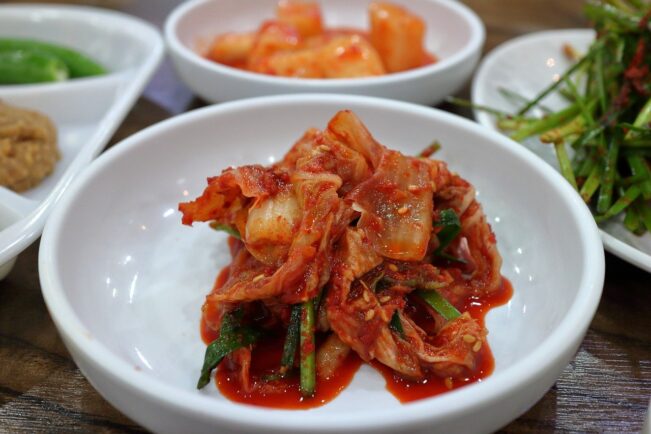What is Kimchi?
Kimchi has been a staple dish in Korean cuisine for at least 2000 years. While it is a generic term referring to salted and fermented vegetables, most people are familiar with a mostly cabbage kimchi that has a kick of spiciness coming from garlic, ginger, and gochugaru (Korean-style red pepper flakes). In this recipe, we will add carrots and green onion, but feel free to get more creative at home by adding whatever veggies you may have on hand. At a time when you are likely making fewer trips to the grocery store than usual, this is a great way to give new life to veggies that may be slightly past their prime, and will potentially allow them to last for months in the refrigerator.
What nutrients does kimchi contain?
In 2008, Health magazine named kimchi one of “the world’s healthiest foods”. There’s no denying it’s an all-round healthy choice, as kimchi is low in calories and high in vitamins (such as beta carotene, B-complex vitamins, and vitamin C), minerals (Na, Ca, K, Fe, and P), and dietary fiber [1]. Depending on the amount of red pepper added, it also contains varying levels of the chemical capsaicin, which can help to stimulate fat loss by activating catecholamine release and speeding up energy metabolism [1].
What makes kimchi good for gut health?
As a fermented food, kimchi offers many health benefits through the activity of probiotic bacteria living in the dish. Although you will not add a specific bacterial culture to the recipe, many species of microbes from the air in your home will be drawn to the vegetable mixture. The purpose of adding salt (aside from flavor) is to suppress the growth of harmful species while allowing lactic acid bacteria (probiotic species) to thrive and dominate as the food ferments [1].
Probiotics isolated from kimchi cultures have been demonstrated to prevent adhesion of pathogenic bacteria in the gut, promote healthy inflammation levels, and have antioxidant activities [2]. A common concern with probiotics is that they will not survive the journey from the food to the gut, due to the harsh conditions created by stomach acid and bile secreted for digestion. Probiotic species from kimchi have been shown to not only survive these conditions but also adhere securely to human intestinal cells, providing evidence to support kimchi’s probiotic value in the diet [2,3].
What if I have existing gut health issues?
If you have concerns about the health of your gut or are experiencing “leaky gut” syndrome, kimchi could be a great addition to your diet. Probiotics like those found in kimchi can have a positive effect on the balance of the gut microbiome, which in turn supports the healing of a leaky gut [3]. Kimchi also contains dietary fiber, which feeds the probiotic microbial species and encourages their multiplication in the gastrointestinal tract. Last but not least, this kimchi recipe is free of gluten, pseudo-grains, seeds, legumes, refined sugar, and dairy, which are all possible contributors to a leaky gut.
Recipe: Kimchi for Gut Health
Ingredients
- 1 whole napa cabbage, chopped into bite-sized pieces (reserve 2 whole leaves to top jars)
- 6 carrots, julienned
- ¼ cup natural sea salt
- 8 cloves of garlic
- 8 green onions, roughly chopped
- 3 tablespoons gochugaru (can be adjusted for more or less heat)
- 2 cubic inches of ginger root, peeled
- 1 tablespoon honey
- 2 tablespoons fish sauce (can be substituted with tamari for a vegan alternative)
Instructions
1. Put the chopped cabbage in a bowl and fill the bowl with enough room temperature water to submerge all of the cabbage. Add sea salt and stir until dissolved. Put a small plate in the bowl on top of the cabbage to keep all of it submerged and leave the whole mixture out at room temperature overnight (or for at least 6 hours).
2. Make a paste in a food processor from the garlic, ginger, gochugaru, honey, and fish sauce (or tamari).
3. Drain chopped cabbage, reserving the salt water. Rinse it with fresh water and squeeze excess water from the cabbage. Put the cabbage back into the empty bowl and toss with carrots and green onions to incorporate them. Add the spice paste to the mixture and use clean hands to massage spices into the vegetables, coating everything evenly.
4. Pack the veggie mixture into jars leaving about an inch of space at the top. Pour just enough of the reserved salt water into each jar to cover the veggies. Place the large pieces of the whole cabbage leaves you saved on top of each jar. Then, push them down to keep the kimchi wedged under water.
5. Put the tops on the jars loosely, so that gases can escape during the fermentation process. You’ll want to store the jars somewhere at room temperature for 3 days. Place jars either in a basin or on a tray in case of overflow due to fermentation. If you notice the cabbage breaking the top of the liquid, open the jars and push the veggies down so they remain submerged.
6. After three days at room temperature, screw the jar lids tight and move them to the fridge. You can eat it now, but we recommend letting flavors develop and fermentation continue. It will go slower if fermenting in cold temperatures. Kimchi will stay good in the fridge for a few months as long as the salt brine stays above the veggies.
7. If you need serving suggestions, kimchi is delicious over rice, pairs well with eggs, and can be tossed with noodles or served as a side to BBQ meats. It is also a wonderful snack all on its own. Grab a fork and try it right from the jar!
References
- https://www.frontiersin.org/articles/10.3389/fmicb.2016.01493/full
- https://www.sciencedirect.com/science/article/abs/pii/S095816691630266X
- https://aspenjournals.onlinelibrary.wiley.com/doi/abs/10.1177/0884533611423926

One thought on “Probiotic Foods: Kimchi for Gut Health”
Comments are closed.